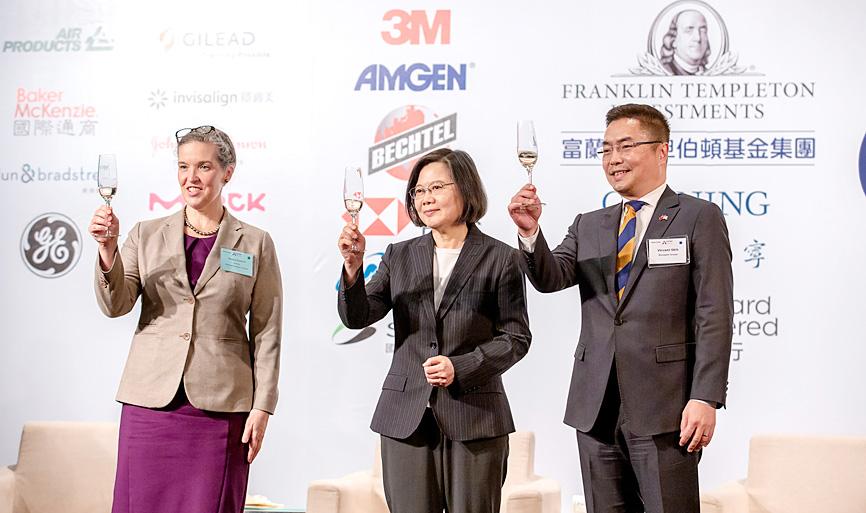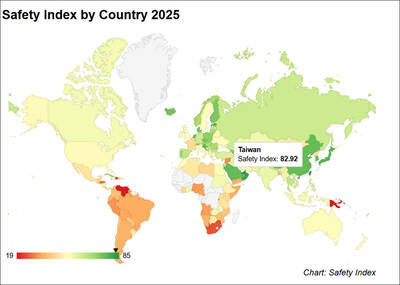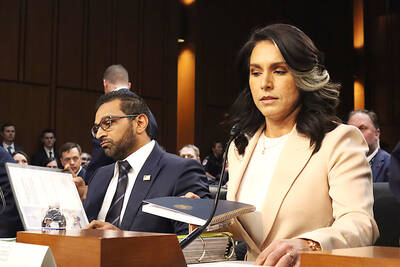Enhancing Taiwan’s role as “a regional security partner” and promoting global supply chain resilience are among the top priorities of the American Institute in Taiwan (AIT) in the second year of US President Joe Biden’s presidency, AIT Director Sandra Oudkirk said on Wednesday evening.
Speaking at the annual Hsieh Nien Fan (謝年飯) banquet hosted by the American Chamber of Commerce in Taiwan, Oudkirk said that the US-China relationship is facing challenges in areas such as trade and human rights, while the US is also concerned about Beijing’s ties with Moscow, especially after Russia’s invasion of Ukraine.
In the Indo-Pacific region, China’s aggressive behavior is especially obvious in Taiwan, where Beijing continues to exert military, diplomatic and economic pressure, she said.

Photo: CNA
China continues to “choke Taiwan’s international space, pressure its friends and interfere in Taiwan’s democratic system,” which poses a threat to all democratic countries, she said.
China’s provocative military activities near Taiwan are disrupting stability and peace in the region, she added.
To counter China’s actions, the US would continue “standing with allies and partners to advance our shared prosperity, security and values in the region,” which is at the core of Biden’s foreign policy, Oudkirk said before discussing the AIT’s objectives.
First, the US would continue to assist Taiwan in enhancing its defensive capabilities to improve “Taiwan’s role as a regional security partner,” as stability across the Taiwan Strait is key to regional peace and in the US’ interests, she said.
The US is “deeply concerned by ongoing PRC [People’s Republic of China] efforts to undermine that stability,” she added.
Second, the US would work with Taiwan to bolster global supply chain resilience through a series of initiatives, as Taiwan is at the center of the semiconductor supply chain, and a pioneer in 5G technology and artificial intelligence, Oudkirk said.
Taiwan would play a crucial role in the recovery of supply chains affected by the COVID-19 pandemic, she added.
The US is to use the Technology Trade and Investment Collaboration framework to encourage investment in semiconductors, electric vehicles, cybersecurity, renewable energy and energy storage from both sides, she said.
The AIT this summer is to form trade delegations to visit the US to discuss the framework, which would help “build scalable eco-systems and enhance collaboration between and among companies, research institutions and innovation centers,” she added.
Third, the US would keep “supporting efforts to preserve and expand Taiwan’s international space,” offering more opportunities for Taiwan to share its expertise at multilateral forums and interact with international partners, she said.
The institute would also strive to deepen “economic and people-to-people ties” between the US and Taiwan in high-tech fields and beyond, she said.
Taiwan was the sixth-largest consumer of US agricultural products and the US’ eighth-largest trade partner in goods last year, with per capita trade only behind Canada and Mexico, she said.
Last year, the US and Taiwan relaunched Trade and Investment Framework Agreement talks and held the second Economic Prosperity Partnership Dialogue, which would promote economic cooperation between the nations and help “build a coalition to counter the PRC’s unfair economic and investment policies,” she added.

AIR SUPPORT: The Ministry of National Defense thanked the US for the delivery, adding that it was an indicator of the White House’s commitment to the Taiwan Relations Act Deputy Minister of National Defense Po Horng-huei (柏鴻輝) and Representative to the US Alexander Yui on Friday attended a delivery ceremony for the first of Taiwan’s long-awaited 66 F-16C/D Block 70 jets at a Lockheed Martin Corp factory in Greenville, South Carolina. “We are so proud to be the global home of the F-16 and to support Taiwan’s air defense capabilities,” US Representative William Timmons wrote on X, alongside a photograph of Taiwanese and US officials at the event. The F-16C/D Block 70 jets Taiwan ordered have the same capabilities as aircraft that had been upgraded to F-16Vs. The batch of Lockheed Martin

GRIDLOCK: The National Fire Agency’s Special Search and Rescue team is on standby to travel to the countries to help out with the rescue effort A powerful earthquake rocked Myanmar and neighboring Thailand yesterday, killing at least three people in Bangkok and burying dozens when a high-rise building under construction collapsed. Footage shared on social media from Myanmar’s second-largest city showed widespread destruction, raising fears that many were trapped under the rubble or killed. The magnitude 7.7 earthquake, with an epicenter near Mandalay in Myanmar, struck at midday and was followed by a strong magnitude 6.4 aftershock. The extent of death, injury and destruction — especially in Myanmar, which is embroiled in a civil war and where information is tightly controlled at the best of times —

Taiwan was ranked the fourth-safest country in the world with a score of 82.9, trailing only Andorra, the United Arab Emirates and Qatar in Numbeo’s Safety Index by Country report. Taiwan’s score improved by 0.1 points compared with last year’s mid-year report, which had Taiwan fourth with a score of 82.8. However, both scores were lower than in last year’s first review, when Taiwan scored 83.3, and are a long way from when Taiwan was named the second-safest country in the world in 2021, scoring 84.8. Taiwan ranked higher than Singapore in ninth with a score of 77.4 and Japan in 10th with

SECURITY RISK: If there is a conflict between China and Taiwan, ‘there would likely be significant consequences to global economic and security interests,’ it said China remains the top military and cyber threat to the US and continues to make progress on capabilities to seize Taiwan, a report by US intelligence agencies said on Tuesday. The report provides an overview of the “collective insights” of top US intelligence agencies about the security threats to the US posed by foreign nations and criminal organizations. In its Annual Threat Assessment, the agencies divided threats facing the US into two broad categories, “nonstate transnational criminals and terrorists” and “major state actors,” with China, Russia, Iran and North Korea named. Of those countries, “China presents the most comprehensive and robust military threat